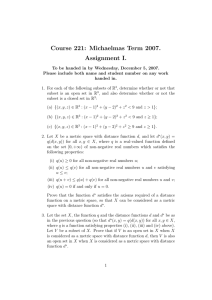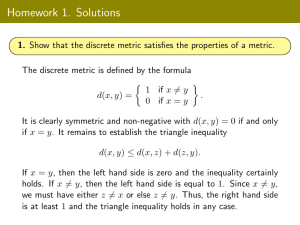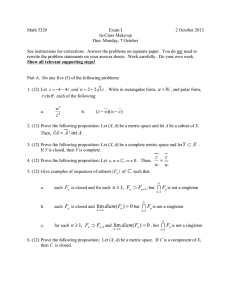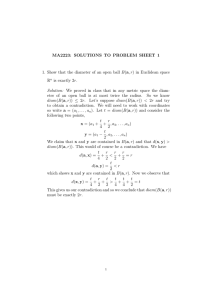MA2223: SOLUTIONS TO ASSIGNMENT 1 :
advertisement
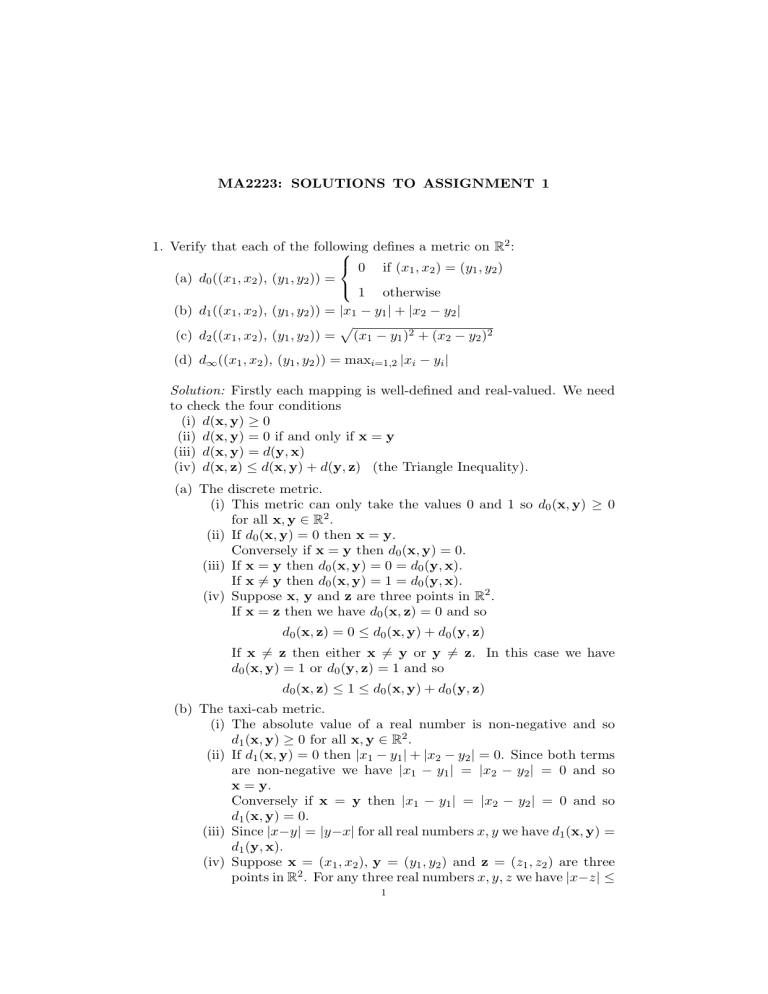
MA2223: SOLUTIONS TO ASSIGNMENT 1
1. Verify that each of the following
defines a metric on R2 :
0 if (x1 , x2 ) = (y1 , y2 )
(a) d0 ((x1 , x2 ), (y1 , y2 )) =
1 otherwise
(b) d1 ((x1 , x2 ), (y1 , y2 )) = |x1 − y1 | + |x2 − y2 |
p
(c) d2 ((x1 , x2 ), (y1 , y2 )) = (x1 − y1 )2 + (x2 − y2 )2
(d) d∞ ((x1 , x2 ), (y1 , y2 )) = maxi=1,2 |xi − yi |
Solution: Firstly each mapping is well-defined and real-valued. We need
to check the four conditions
(i) d(x, y) ≥ 0
(ii) d(x, y) = 0 if and only if x = y
(iii) d(x, y) = d(y, x)
(iv) d(x, z) ≤ d(x, y) + d(y, z) (the Triangle Inequality).
(a) The discrete metric.
(i) This metric can only take the values 0 and 1 so d0 (x, y) ≥ 0
for all x, y ∈ R2 .
(ii) If d0 (x, y) = 0 then x = y.
Conversely if x = y then d0 (x, y) = 0.
(iii) If x = y then d0 (x, y) = 0 = d0 (y, x).
If x 6= y then d0 (x, y) = 1 = d0 (y, x).
(iv) Suppose x, y and z are three points in R2 .
If x = z then we have d0 (x, z) = 0 and so
d0 (x, z) = 0 ≤ d0 (x, y) + d0 (y, z)
If x 6= z then either x 6= y or y 6= z. In this case we have
d0 (x, y) = 1 or d0 (y, z) = 1 and so
d0 (x, z) ≤ 1 ≤ d0 (x, y) + d0 (y, z)
(b) The taxi-cab metric.
(i) The absolute value of a real number is non-negative and so
d1 (x, y) ≥ 0 for all x, y ∈ R2 .
(ii) If d1 (x, y) = 0 then |x1 − y1 | + |x2 − y2 | = 0. Since both terms
are non-negative we have |x1 − y1 | = |x2 − y2 | = 0 and so
x = y.
Conversely if x = y then |x1 − y1 | = |x2 − y2 | = 0 and so
d1 (x, y) = 0.
(iii) Since |x−y| = |y−x| for all real numbers x, y we have d1 (x, y) =
d1 (y, x).
(iv) Suppose x = (x1 , x2 ), y = (y1 , y2 ) and z = (z1 , z2 ) are three
points in R2 . For any three real numbers x, y, z we have |x−z| ≤
1
2
MA2223: SOLUTIONS TO ASSIGNMENT 1
|x − y| + |y − z|. Thus
d1 (x, z) = |x1 − z1 | + |x2 − z2 |
≤ |x1 − y1 | + |y1 − z1 | + |x2 − y2 | + |y2 − z2 |
= d1 (x, y) + d1 (y, z)
(c) The Euclidean metric.
(i) The square root of a non-negative real number is a non-negative
real number and so d2 (x, y) ≥ 0 for all x, y ∈ R2 .
(ii) If d2 (x, y) = 0 then (x1 − y1 )2 + (x2 − y2 )2 = 0. Since both
terms are non-negative we have x1 − y1 = x2 − y2 = 0 and so
x = y.
Conversely if x = y then (x1 − y1 )2 = (x2 − y2 )2 = 0 and so
d2 (x, y) = 0.
(iii) Since (x − y)2 = (y − x)2 for all real numbers x, y we have
d2 (x, y) = d2 (y, x).
(iv) We proved the triangle inequality in class. It is a consequence
of the Cauchy-Schwarz inequality.
(d) The maximum metric.
(i) The absolute value of a real number is non-negative and so
d∞ (x, y) ≥ 0 for all x, y ∈ R2 .
(ii) If d∞ (x, y) = 0 then |x1 − y1 | = |x2 − y2 | = 0 and so x = y.
Conversely if x = y then |x1 − y1 | = |x2 − y2 | = 0 and so
d∞ (x, y) = 0.
(iii) Since |x−y| = |y−x| for all real numbers x, y we have d∞ (x, y) =
d∞ (y, x).
(iv) Suppose x = (x1 , x2 ), y = (y1 , y2 ) and z = (z1 , z2 ) are three
points in R2 . For any three real numbers x, y, z we have |x−z| ≤
|x − y| + |y − z|. In particular we have
|x1 − z1 | ≤ |x1 − y1 | + |y1 − z1 |
≤ max |xi − yi | + max |yi − zi |
i=1,2
i=1,2
= d∞ (x, y) + d∞ (y, z)
Similarly we have
|x2 − z2 | ≤ |x2 − y2 | + |y2 − z2 |
≤ max |xi − yi | + max |yi − zi |
i=1,2
i=1,2
= d∞ (x, y) + d∞ (y, z)
Combining these two observations we have
d∞ (x, z) = max |xi − zi | ≤ d∞ (x, y) + d∞ (y, z)
i=1,2
2. For each of the metrics in Question 1, describe the open ball B(0, 1) and
the sphere S(0, 1) in R2 . (Use pictures).
Solution:
(a) The open ball consists of a single point, the origin {(0, 0)}. The
sphere consists of all points in R2 except for the origin.
MA2223: SOLUTIONS TO ASSIGNMENT 1
3
1.0
0.5
-1.0
0.5
-0.5
1.0
-0.5
-1.0
Figure 1. Taxi-cab metric
1.0
0.5
-1.0
0.5
-0.5
1.0
-0.5
-1.0
Figure 2. Euclidean metric
1.0
0.5
-1.0
0.5
-0.5
1.0
-0.5
-1.0
Figure 3. Maximum metric
(b) The sphere is a diamond shape, the open ball is the interior of this
diamond. See Figure 1.
(c) The sphere is the circle with centre (0, 0) and radius 1. The open
ball is the interior of this circle. See Figure 2.
(d) The sphere is a square, the open ball is the interior of this square.
See Figure 3.
3. Prove that the union of two bounded sets is a bounded set.
4
MA2223: SOLUTIONS TO ASSIGNMENT 1
Solution: Suppose (X, d) is a metric space and A and B are bounded
subsets of X. Choose a point x ∈ A and y ∈ B. Let
r = diam(A) + diam(B) + d(x, y) + 1
We proved in class that a set is bounded if and only if it has finite diameter
so both diam(A) and diam(B) are finite. We claim that A∪B is bounded
because it is contained in the open ball B(x, r).
If z ∈ A ∪ B then either z ∈ A or z ∈ B. If z ∈ A then
d(x, z) ≤ diam(A) < r
and so z ∈ B(x, r). If z ∈ B then using the triangle inequality
d(x, z) ≤ d(x, y) + d(y, z) ≤ d(x, y) + diam(B) < r
and again this shows z ∈ B(x, r). We have proved our claim that A ∪ B
is contained in B(x, r).


